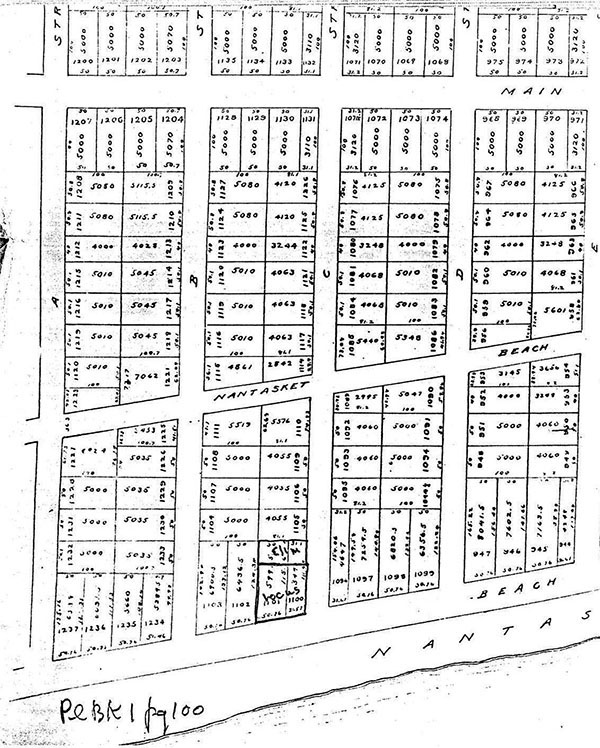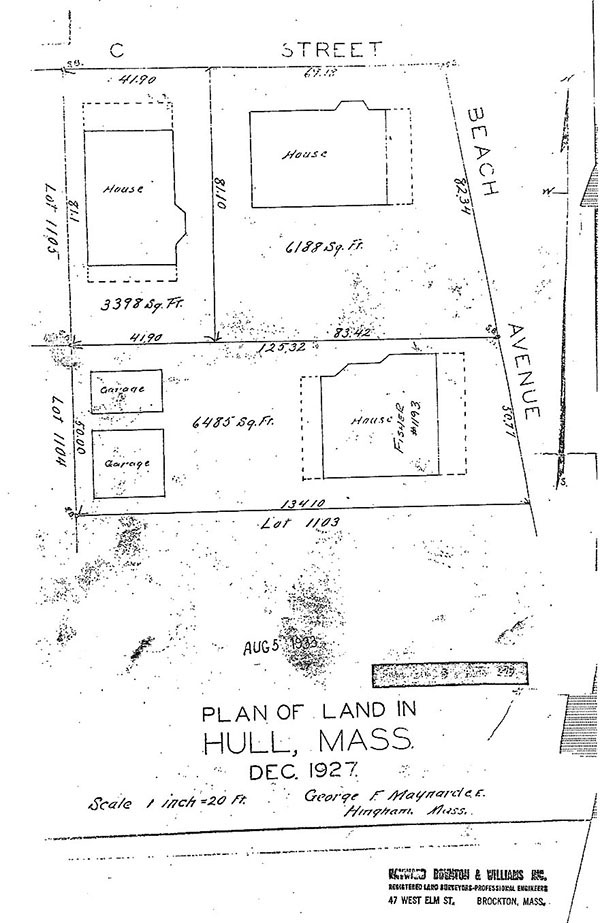The plaintiffs, Rita L. Fisher and Lori Jane Fisher, owners of the premises known as and numbered 193 Beach Avenue in Hull in the County of Plymouth, brought a complaint in this Court against the defendants, Lawrence c. Perlmutter and Ina G. Perlmutter, owners of the adjoining premises at 197 Beach Avenue in said Hull, in which they seek to establish ownership to a strip of land between the properties of the parties on which a driveway is located.
A trial was held at the Land Court on June 22 and 28, 1979 with a view being taken by the judge on August 9. At the trial a stenographer was appointed to record the testimony with all exhibits introduced into evidence being incorporated herein for the purpose of any appeal.
The parties stipulated at the commencement of the trial that 1) abstracts of title prepared by Phillip S. Cronin, Esquire, a Land Court Examiner, and covering the two properties owned by the parties might be admitted in evidence; 2) the record title to the driveway in question is in the defendants; and 3) two garages at the end of the driveway situated behind the plaintiffs' house, one for a single car and the other for two cars, are on property owned by the plaintiffs. [Note 1]
On all the evidence I find and rule as follows:
That Mary J. Grady of Arlington in the County of Middlesex was a predecessor in title to both the plaintiffs and the defendants; that by deed dated November 24, 1911 and recorded with Plymouth Deeds, Book 1110, Page 50, Frank A. Schirmer et al conveyed to her Lots Nos. 1100, 1101 and 1102 on a Plan recorded in Plan Book 1, Page 100, a copy of which is attached hereto; [Note 1a] that the plaintiffs are the record owners of said Lot 1102 and the defendants of the major portions of said Lots Nos. 1100 and 1101 on said plan; that by instrument dated January 12, 1928 and recorded with Plymouth Deeds, Book 1544, Page 517, she mortgaged the property now owned
by the plaintiffs to Lincoln Savings Bank which foreclosed its mortgage by entry and exercise of the power of sale in April of 1940; that through mesne conveyances title to 193 Beach Street was acquired by Minnie Poverman from Anthony Cola et al by deed dated May 26, 1949 and recorded with said Deeds, Book 2047, Page 350; that Mrs. Poverman is the mother of the plaintiff, Rita L. Fisher, and the grandmother of the other plaintiff who is Mrs. Fisher's daughter; that Mrs. Poverman and her husband conveyed title to Mrs. Fisher and Mrs. Poverman as joint tenants by deed
dated June 16, 1964 and recorded with said Deeds, Book 3117, Page 4; that thereafter the grantees in the latter deed conveyed the 193 Beach Street premises to the plaintiffs by deed dated January 22, 1976 and recorded with said Deeds, Book 4134, Page 287; that in said mortgage there was no express grant of an easement across the grantor's remaining land for a driveway; that title to the property at 197 Beach Street was devised by Mrs. Grady to her husband, Joseph W. Grady, who in turn conveyed it to Sidney W. Grossman et al by deed dated January 10, 1940 and recorded with said Deeds, Book 1786, Page 141; that there is reference therein to a right of way but that such way is not that in question here; and that the defendants acquired title to their locus by two deeds from Sidney W. Grossman and Frances A. Grossman, each conveying an undivided one-half interest, dated October 25, 1974 and December 1974 and recorded with said Deeds, Book 4029, Page 718 and Book 4042, Page 333, respectively.
I further find and rule that the driveway was an unpaved dirt path of approximately ten feet in width when Mrs. Poverman acquired Lot No. 1102 in 1949; that it was separated by a row of bushes from the premises at 197 Beach Street; that in either 1969 or 1970 Paul Fisher, the husband of the plaintiff Rita L. Fisher, had the driveway hardtopped; that it is now approximately the same width as it was prior to its surfacing; that the driveway has been used
for access to and egress from Beach Avenue, the plaintiffs' garages and the paved back yard; that at times the plaintiffs exit from the yard to Beach Avenue on the opposite side of their home from the defendants' property; that occasionally the plaintiffs or those claiming under them have parked a car in the driveway primarily to wash it or for some other usual purposes, but its principal use has been as a way affording access on foot or by vehicles to the yard; that such use has continued openly, notoriously, continuously and adversely for thirty years by the plaintiffs or their predecessors in title; that after the great blizzard of February 1978 Paul Fisher made arrangements to have the debris deposited by reason of the storm removed at his expense; that the defendants' predecessors in title occupied the 197 Beach Avenue premises during the first years of its acquisition and in World War II but thereafter rented it through a real estate agent for many years; that Mrs. Grossman occasionally would use the driveway to park her car and bring purchases into the house through the row of bushes; that this practice was resumed by the defendants when they acquired title to the property but has been virtually discontinued because of objections by the plaintiffs or members of their family; that in 1972 the defendants erected a chain link fence on the side of the bushes closer to their house; and that consequently the defendants' premises cannot now be reached from the driveway.
The principles applicable to this case have been stated repeatedly. The burden of proof is on the plaintiffs who are claiming that they have acquired title to the land on which the driveway is located by adverse possession or alternatively that they have acquired a prescriptive right to use the driveway for all usual purposes. Gadreault v. Hillman, 317 Mass. 656 , 661
(1945); McDonough v. Everett, 237 Mass. 378 , 383-84 (1921). If one views the property as the Court did, it appears to the uninitiated from the location of the row of bushes and the defen- dants' fence that the driveway is an integral part of the plaintiffs' premises. All the evidence in the case, however, is more consistent with the acquisition by the plaintiffs and their predecessors of a prescriptive easement to use the driveway. In addition to the nature of the plaintiffs' use as outlined above, the town of Hull has always assessed to the defendants and their predecessors in title the real estate taxes on the property owned by the defendants of record which includes the ten foot wide strip in question. In order to bear their burden of proving a prescriptive easement the plaintiffs must show that their use has been "open, notorious, continuous and adverse use for a period of twenty years." Ryan v. Stavros, 348 Mass. 251 , 262 (1964); Van Allen v. Sweet, 239 Mass. 571 , 574 (1921); G. L. c. 187, §2. The use, however, need not be exclusive. Bills v. Nunno, Mass. App. Ct. (1976); [Note 2] Bigelow Carpet Co. v. Wiggin, 209 Mass. 542 , 548 (1911). The fact that the defendants may not have been aware of the plaintiffs' use is immaterial when it was so apparent and could have been viewed by the owners from time to time of 197 Beach Avenue if they had visited the locus or communicated with the tenants. Foot v. Bauman, 333 Mass. 214 , 218 (1955). To the extent that the use of the driveway was seasonal, this does not bar a finding of continuity. Mahoney v. Heebner, 343 Mass. 770 (1961); Lawrence v. Houghton, 296 Mass. 407 , 409 (1936). There is no doubt from the evidence that all elements necessary to establish an easement were shown, and I therefore find and rule that the plaintiffs have borne the burden of establishing their right to use the driveway between the respective properties of the parties; that their use thereof (and that of their predecessors) has been open, notorious, continuous and adverse for more than twenty years; that such easement is appurtenant to the premises at 193 Beach Avenue; that the driveway may be used both for access and egress; that such use is to be in common with the owners of the servient tenement and any others entitled; and that the parties hereto are to exercise their rights in the driveway in such a way as to cause the least possible interference with their respective rights and the rights, if any, of others.
It was apparent at the trial that the parties might find guidance from the Court on the future use of the driveway helpful. The use by the plaintiffs is to be for access to and egress from their premises and Beach Avenue. They are not to park in the driveway other than for short periods necessary perhaps to rearrange the cars parked in the back yard. They have the right,
as owners of the dominant tenement, to make at their expense any repairs to the surface of the driveway which they elect so long as the rights of others are respected. They cannot trim the row of bushes other than to prevent any interference with their use of the driveway or any blocking of the visibility as they exit from the driveway onto Beach Avenue. Title to the driveway remains in the defendants, and they have an equal right to use it. For example, if it is physically possible to provide an access from it to the defendants' back yard, they are free to do so. They can park for short periods in the driveway to complete any errands, but the parking must be of a limited duration if the plaintiffs desire access or egress at that particular time. If the plaintiffs' motor vehicles are out and their drivers not desirous of immediate re-entry, the Court will not prevent the defendants at such times from using the driveway. [Note 3]
In their complaint the plaintiffs have requested an award of damages in the amount of$75,000 for the value of the maintenance and improvements made by the plaintiffs to the driveway. It is well settled in this Commonwealth, however, that the owner of the dominant tenement has the duty of making any repairs which he may wish to the easement area, and accordingly any claim for damages is hereby denied.
Judgment accordingly.
 RITA L. FISHER and LORI JANE FISHER vs. LAWRENCE C. PERLMUTTER and INA G. PERLMUTTER.
RITA L. FISHER and LORI JANE FISHER vs. LAWRENCE C. PERLMUTTER and INA G. PERLMUTTER.

